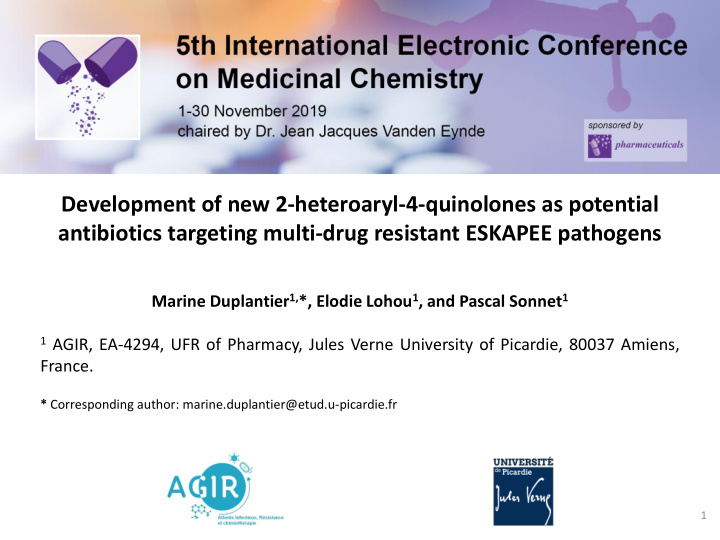



Development of new 2-heteroaryl-4-quinolones as potential antibiotics targeting multi-drug resistant ESKAPEE pathogens Marine Duplantier 1, *, Elodie Lohou 1 , and Pascal Sonnet 1 1 AGIR, EA-4294, UFR of Pharmacy, Jules Verne University of Picardie, 80037 Amiens, France. * Corresponding author: marine.duplantier@etud.u-picardie.fr 1
Development of new 2-heteroaryl-4-quinolones as potential antibiotics targeting multi-drug resistant ESKAPEE pathogens Graphical Abstract OR Bacterial multiplication ROS Cell death Development of biofilms Expression of virulence factors Quorum Sensing inhibitors Respiratory chain inhibitors 2
Abstract: Multi-drug resistant ESKAPEE pathogens are responsible for various nosocomial infections. Considering this serious threat to public health, new efficient treatments are urgently needed. The bacterial communication systems, called quorum sensing (QS), constitute a pool of new promising pharmacological targets for the development of antimicrobial molecules. The inhibition of QS could disrupt several intra/inter-species protective interactions (bacterial multiplication, biofilm formation) and virulence pathways. The intervention of three main small signaling molecules was described in the pqs intercellular communication system of P. aeruginosa : the Pseudomonas quinolone signal (PQS), its precursor 2-heptyl-4(1 H )-quinolone (HHQ) and the 2-heptyl-4-hydroxyquinoline- N -oxide (HQNO) as a secondary metabolite from this pathway. Interestingly, HQNO appears to be a potent respiratory chain inhibitor for various competing microorganisms such as S. aureus . Furthermore, HHQ analogues and different 2-heteroaryl-4-quinolone series revealed efficient as QS inhibitors (PQS receptor antagonists) or as type II NADH/quinone oxidoreductase inhibitors. Taking these studies into account, the interest of the quinolone scaffold in the design of QS and respiratory chain inhibitors has emerged. In this context, we aim to develop new antibacterial 2-heteroaryl-4-quinolone series. The synthesis of the first series carrying out pallado-catalyzed C-C or C-N coupling reactions from 2-bromo-4- chloroquinoline precursors will be described in the presentation. Keywords: ESKAPEE pathogens; bacterial communication systems; quorum sensing; quinolones; pallado-catalysed cross-coupling reactions. 3
Introduction Infectious diseases are a serious threat to public health: – Second cause of death in the world with 700 000 deaths/year – Emergence of multi-resistant strains in ESKAPEE pathogens Antibiotic resistance mechanisms of bacteria Antibiotic resistance = Urgent need to find new treatments
Introduction Quorum Sensing (QS) = Pool of bacterial communication systems regulating several intra/inter-species protective interactions and virulence pathways in response of environment factors P. aeruginosa main communication system 1 Promising potential therapeutic targets for the development of new antibiotics (1) Chem. Sci. , 2017 , 8 , 7403-7411.
Introduction Development of QS inhibitors P. aeruginosa main communication system 6-nitro-HHQ-3-carboxamide 2 The introduction of a strong hydrogen bond acceptor group in position 6 of a HHQ analogue allowed the increase of the PqsR antagonist activity. (2) Org. Biomol. Chem., 2017 , 15, 4620-4630.
Introduction Development of respiratory chain inhibitors 2-phenyl and 2-pyridinyl-4-quinolones 3,4 P. aeruginosa main communication system (3) J. Med. Chem., 2017 , 60 , 3703-3726 ; (4) J. Med. Chem., 2012 , 55 , 1844-1857.
Introduction Taking these literature data into account, we decided to develop a 2-heteroaryl-4- quinolone family in order to find new potential antibiotics against ESKAPEE pathogens. These compounds could be active against two types of bacterial targets implicated in protective or virulence pathways.
Introduction Synthesis strategy The synthesis of the expected 2-heteroaryl-4-quinolones relies on palladium- catalyzed cross-coupling reactions between the 2-bromo-4-chloroquinoline and a heteroarylboronic ester (series I ) or a N -heteroarylpiperazine derivative (series II ). Series I : Synthesis of 2-heteroaryl-4-quinolones Suzuki coupling reaction Series II : Synthesis of 2-(4-heteroarylpiperazin-1-yl)-4-quinolones Buchwald-Hartwig coupling reaction R = H, Cl, NO 2 , CN, NH 2 ...
Results and discussion Synthesis of diversely substituted 2-bromo-4-chloroquinoline precursors 5,6 7 The 2-bromo-4-chloroquinoline precursors 3a-c were synthetized carrying out a selective bromination in position 2 of the corresponding 4-chloroquinoline N -oxides 2a-c . 8 One of the first pharmacomodulation realized on the quinoline core corresponds to the introduction of a cyano group in position 6. In presence of an excess of Zn(CN) 2 , the 4,6-dicyano derivative was mostly obtained. After an optimization of the reactant amounts, the desired product was finally prepared in good yield. (5) WO 2012/069856A1; (6) J. Med. Chem., 2012 , 55 , 1844-1857 ; (7) Tetrahedron letters , 2014 , 55 , 7130-7132 ; (8) EP2742039B1. 10
Results and discussion Synthesis of the second heteroaryl building blocks • In the series I , a Miyaura borylation reaction provided the heteroarylboronic ester 5 . • In the series II , the N -heteroarylpiperazine derivative 6 was prepared using a Buchwald-Hartwig coupling. This synthesis was optimized changing the BINAP ligand for XantPhos with an improved yield of 71% vs 24%. A subsequent catalytic hydrogenation successfully allowed the N -Cbz removal to prepare compound 7 thus available for a second C-N coupling. 11
Results and discussion Palladium-catalyzed cross-coupling C-C or C-N reactions in position 2 of quinoline scaffold 9 5 10 After conversion of the quinoline core of coupling products 8a-c and 10 into a quinolone one under acidic conditions, expected products 9a - c and 11 were respectively obtained. (9) Tetrahedron Letters , 2006 , 47 , 7427-7430 ; (10) Tetrahedron , 2007 , 63 , 13000-13005. 12
Conclusion • Four final products have been synthesized in 4-5 steps . Synthesis of four new promising 2-heteroaryl-4-quinolone derivatives • Pharmacomodulations in positions 5 to 8 of 4-chloroquinoline precursors are currently in progress to develop a wide range of 2-heteroaryl-4-quinolones. • The antibiotic activity of these potential QS or respiratory chain inhibitors against different bacteria species, especially A. baumannii and P. aeruginosa, will shortly be evaluated to identify a first lead compound . 13
Acknowledgments We would like to thank the Hauts-de-France region and the University of Picardie Jules Verne for their financial support. 14
Recommend
More recommend